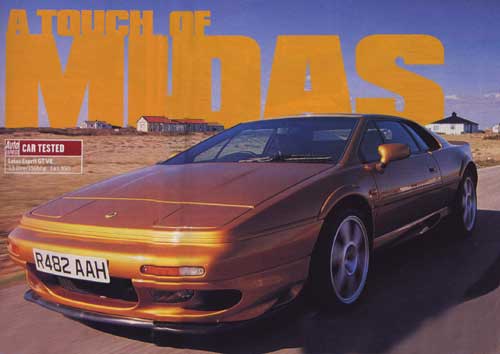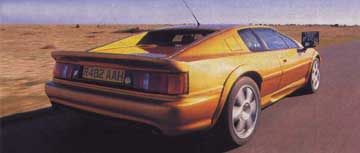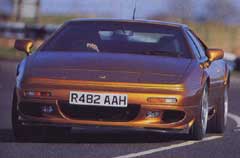

ROAD TEST: Lotus Esprit V8-GT
At last... Lotus has produced the Esprit
every true sports car fan has been waiting for –
V8 engine, stripped-out interior and £10,000 cheaper!
AutoExpress March 1998
If you can remember 1976, the thing that probably stands out most is how damn hot the summer was. If you aren't old enough, you'll have to take our word for it that temperatures soared to all-time highs. But the sun wasn't the only thing getting people hot and bothered. Lotus Cars has been promising something special for a couple of years, and in 1976 it finally arrived. The Esprit was born.
From a decade where Britain's contribution to the motoring world was inauspicious to say the least, the Lotus Esprit stood out as a gem among a pile of rocks. At the time it looked outrageous: the futuristic and aggressive Giugiaro lines distinguishing it from other traffic in the same way as a Ferrari or Lamborghini. On looks alone, the Esprit suggested everything a supercar should – extravagance, impracticality and, above all, speed.
Twenty-two years on, the Esprit still stands out – which is why Lotus keeps adding extra ingredients to the recipe rather than moving on to a new dish. Hence the new GT, a V8 Esprit without the luxuries of the range-topping model. When Lotus unleashed the original Esprit, it relied on a four-cylinder engine. Although adequate for the job, it undermined the maniacal styling – it was simply not butch enough to satisfy the suggestion of lusty performance. The situation was improved by the addition of a turbocharger; and for several years this kept customers happy. But many people who were entranced by the Esprit's looks wouldn't consider it unless it had a suitable number of cylinders to match rivals: a combination that would put it among the world's most desirable cars.
Finally is came. In 1996, Lotus fitted the Esprit with its own, newly developed V8, and breathed a sigh of relief. Compact, powerful – surely this would satisfy those petitioning for more performance? Not quite! The V8 met with disappointing reviews and it was not long before the firm was openly discussing improvements. The main complaint against the new beast was that the huge single-plate clutch was so heavy to operate, it made the car almost undriveable. An unrefined, imprecise gearshift compounded things, making the entire process of changing up and down something to be feared rather than relished.
And as if that wasn't enough, it transpired that would-be buyers were also hoping for changes to the decidedly date interior, and expected Lotus to sort out the often-troublesome ventilation system. That's why, less than two years later, there's a new version of the Esprit V8. Called the GT, the £49,950 car sits between the four-cylinder GT3 and the top-of-the-range V8, and comes with a new interior, plus the promise that all the engineering gremlins have been sorted out.


Improvement
The price saving over the £60,100 V8 comes through having none of the range-topper's standard luxury trappings. The £10,000-plus reduction means no leather seats, no airbags, no air-con, no metallic paint – though our test car came in a striking shade of gold – and no audio system. The positive side of losing these creature comforts is a significant weight saving, which will please true sports car fans.Whether you value equipment or not, there's no denying the new interior is a vast improvement. At last if feels modern and well put together. Gone are the too-numerous dials and awkward square binnacle which housed them; now there are just four basic instruments nestling snugly under the curvy new cowling. Previously, there were so many warning lights that the Esprit's dash lit up like a Christmas tree. But now they disappear into the background and are only visible if things start to go wrong.
There is a little mound in the expansive dashboard to the left of the driver, in which is mounted a series of push buttons for lights, heated rear screen and the like. Below these are the controls for the heater. It's all very simple – but then a flash interior is not something this car needs. Most importantly, the material quality is superb, and the general finish is excellent.

The GT is a step towards reasserting Lotus' racing heritage. The Norfolk company's doctrine has never been to make cosy cruisers, and maybe that's why the engineers and marketing people are so enthusiastic about this new variant. With all the modern-day comforts tripped out, the car is lighter and is true to what it should have been about in the first place – scintillating performance.
The bucket seats offer more support than the top-spec car's leather ones, but the fact they don't recline may mean restricted headroom for taller drivers. The lack of an airbag almost doesn't matter when you grip the perfectly formed Momo steering wheel: it feels great and the driving position is excellent.
As you turn the ignition key and gun the engine into life, get ready for a shock. The noise – or lack of it – is quite astonishing. Considering those eight cylinders are sitting just behind your left ear, you could be forgiven for expecting utter raucous mayhem. But somebody, somewhere – probably part of a Euro committee – has put an end to musical exhausts, and the Esprit has suffered accordingly. From the moment the clutch pedal sinks calmly to the floor and then huge metal gearshift slides into first, it's clear that what was once an Olympic sport has become a relaxing pastime. The hefty single-plate clutch has been replaced with a twin-plate set-up bought in from AP Racing, which, thankfully, is much more user-friendly.
But no matter how nimble a supercar is on country roads, it is inevitably going to get stuck in traffic now and again. While the Lotus is not the heavy-going beast it was, it can still be tiresome when driving in town – not least because the handbrake is on the right of the driver almost under the dashboard, making hill starts something of an ordeal. The throttle pedal is tucked away in the far corner of the footwell, sandwiched between the brake pedal and bulkhead. To make smooth progress through heavy traffic, you will have to get its position sussed, as you can easily hit the wrong pedal or even both at the same time.
Cars of this nature will always be used as status symbols in cities, spending more time lurking around busy streets than on the open road. It is testament to the design that the Esprit stops traffic wherever it goes. What was once seen as avant-garde has achieved the status of timeless classic. This remains, however, a mere distraction from what the Esprit is all about: serious driving. As you set off on a motorway to find those sumptuous B-roads, you'll begin to understand why so many Esprits are snapped up by Germans. Straight-line speed is incredible, and perfect for autobahns. Pulling away from standstill, you barely get a chance to appreciate the pace before the short gearing necessitates a change-up. Plant the throttle, and the 3.5-litre V8 doesn't pause for a second, the low-down pull delivering bite which is sorely missing in the exhaust bark. Once you're up into the middle of the rev-range, the twin turbochargers take over, and from that point the power delivery is both effortless and devastatingly quick.
Ability
The Lotus rockets from 0-60mph in less than five seconds, the peak power of 350bhp coming at 6500rpm. A limiter cuts in shortly after that, allowing you to push the Esprit to its furthest extent before shoving the gearstick into its next resting place. There's no vibration, no woolly action – just a short, sharp bang from gear to gear. The collaboration between Lotus and Renault to develop the Esprit's ageing transmission to cope with this version's performance has paid off.Even the most cynical driver will raise his eyebrows at the GT's ability. Not only is it shatteringly quick – even if it is limited to 170mph – but it is so eager that if you plant the throttle in any gear, it only takes a fraction of a second before you're hurtling for the horizon, thanks to the whopping 400Nm of torque on tap.
The Lotus Esprit has always enjoyed the balance inherent with a mid-engined car, and together with finely honed controls, this makes it one of the sweetest-handling machines around. Thankfully, nothing has changed with the V8-GT, which feels as controllable as ever. With such an awesome amount of power, it's reactions to maintain balance. The steering is hard to better – it is unbelievably fast and accurate, and its linear feel allows this sizeable motor to dart around rather like a go-kart.
It may turn heads in traffic and go nearly into orbit on an autobahn, but where the Esprit gives the most pleasure is on a racetrack or, more likely, a quiet country road. The levels of grip and handling defy belief, and you'll enter corners ever more quickly as the car refuses to slide or deviate from the desired line. But its real beauty is how it translates into everyday driving. No harshness or backbreaking effort is required to get it to perform. The ride is supple enough to smooth all the rough edges off the tarmac, and those wafer-thin, low-profile tyres return an astonishing amount of comfort, not to mention grip. The ride gets worse in town, but this can be forgiven. And although the steering, pedals and gearshift are firm, their actions have an underlying ease which ensures everything remains controllable. If you give the throttle a heavy-handed squirt or lift off mid-corner, the Esprit will snap out its back end. But it is easily retrievable. Quick-witted drivers will react with more power and opposite lock, ensuring that they'll go on to fight another corner.
The pedals may be a pain for slow driving, but once the car is hustling along their close proximity allows easy, well-executed downchanges. The car also features updated brakes, which at last provide the serious stopping power needed to tame the V8. Together they let the Esprit take the limits of the average driver that little bit further, once they have gained complete faith.
Viewing the Lotus Esprit in the wider scheme of things, it has major advantages over the opposition. For a start, there's the price: at £49,950 it sits way below a whole league of cars, which although substantially more expensive, cannot get close on performance or – arguably – looks. The latter may be down to personal taste, but it simply can't be overlooked – a feelgood factor is important for the owner of any car, but especially an expensive, fast one. If you feel great driving it, you're going to enjoy driving it. And after all, to pilot the same car as James Bond, but several generations on – well, it doesn't get much better than that...
Verdict
The new Esprit V8-GT is a back-to-its-roots move for Lotus – and what smart manoeuvre it has been. The few creature comforts to mollycoddle the driver, and with expensive options – a driver airbag costs nearly £1,500 – adding extras will cost you dear.But the back-to-basics layout of the new, much-improved cabin sits comfortably with the nature of this car, while the transmission changes have improved the driving experience. Performance, of course, speaks for itself: the 350bhp V8-GT is capable of 170mph and sprints from 0-60mph in less than five seconds.
Priced at £49,950, the GT is quite a bargain when you look at the opposition. The Honda NSX and new Porsche 911 are both significantly slower than the Lotus, and cost in excess of £15,000 more – and neither of them can provoke the jaw-dropping reactions this senior citizen can.
Lotus Esprit V8-GT
+ We like: Performance, handling, exquisite, classic styling.
– We don't like: Poor economy, lack of safety gear, tame engine note.
|
|